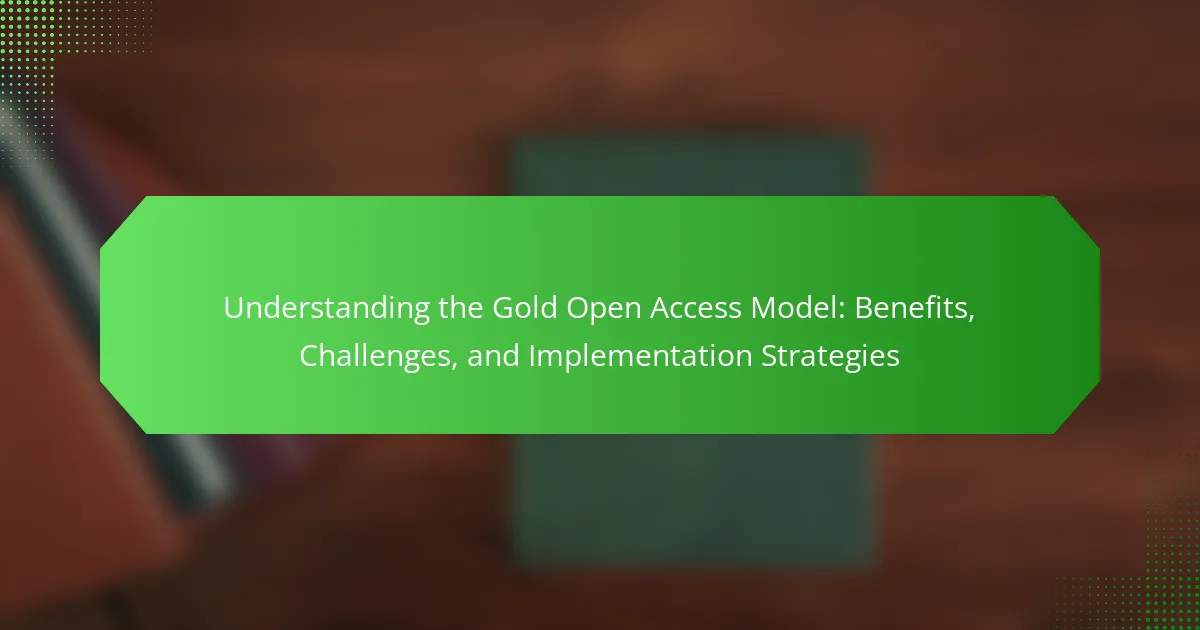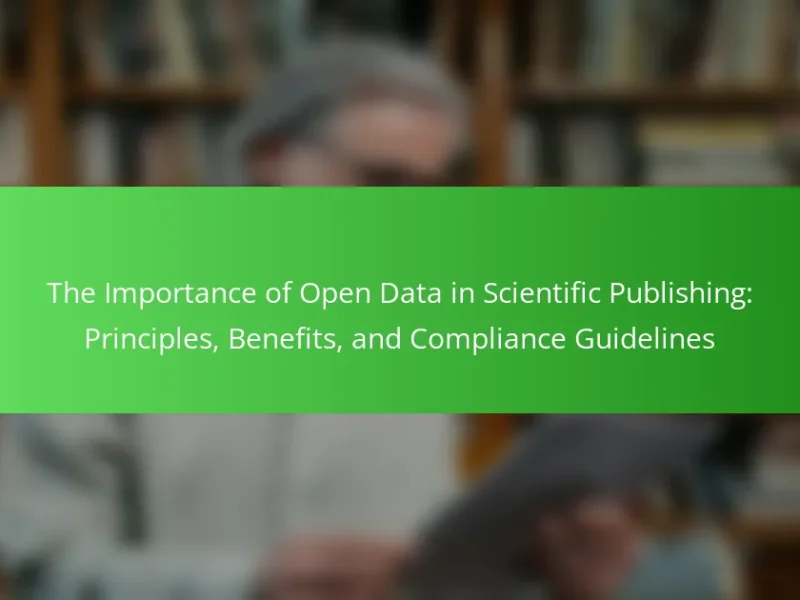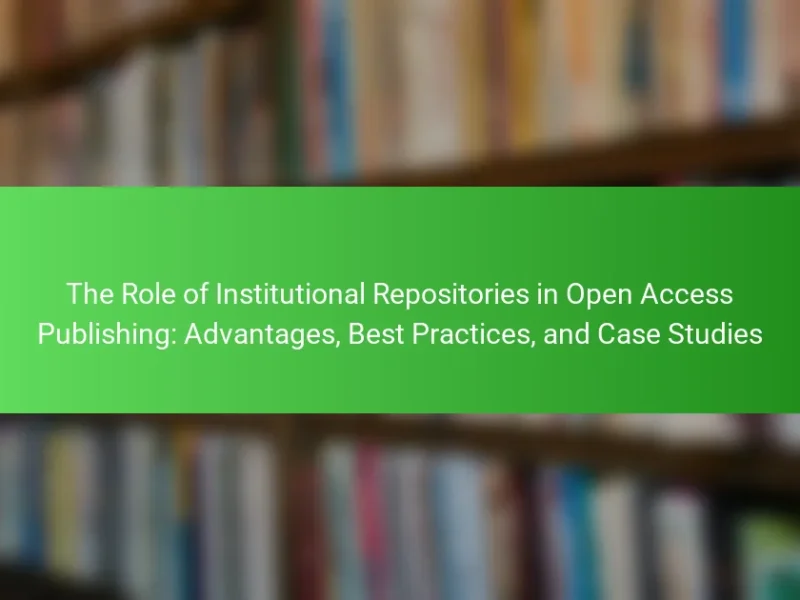The Gold Open Access Model facilitates immediate free access to research articles upon publication, with authors or their institutions typically covering publication costs through article processing charges (APCs). This model enhances the visibility and citation rates of research findings but faces challenges, including financial burdens on authors, potential quality control issues, and disparities in access for researchers from different funding backgrounds. Effective implementation of this model requires institutions to establish clear policies, allocate budgets for APCs, negotiate transformative agreements with publishers, and provide training and support for researchers. Monitoring and assessing open access initiatives are also essential for optimizing their impact on research visibility.
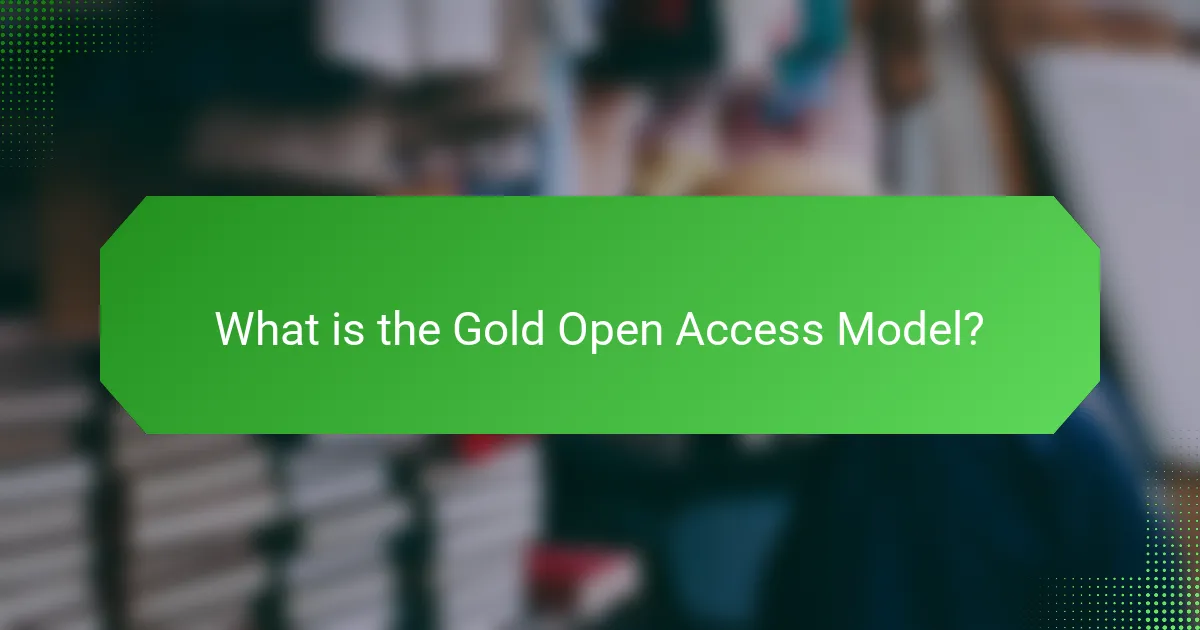
What is the Gold Open Access Model?
The Gold Open Access Model allows free access to research articles immediately upon publication. In this model, authors or their institutions typically pay an article processing charge (APC) to cover publication costs. This ensures that readers can access the content without subscription fees. The model promotes wider dissemination of research findings. It is increasingly adopted by academic journals and publishers. Many funders encourage or require researchers to publish under this model. Studies show that Gold Open Access increases article visibility and citation rates.
How does the Gold Open Access Model differ from other publishing models?
The Gold Open Access Model allows unrestricted access to published research articles. This model differs from traditional publishing models, which often require subscriptions or paywalls for access. In Gold Open Access, authors typically pay an Article Processing Charge (APC) to publish their work. This contrasts with subscription-based models, where readers or institutions pay for access. Gold Open Access enhances visibility and citation potential for authors. Studies show that Gold Open Access articles are cited more frequently than those behind paywalls. This model promotes wider dissemination of knowledge, benefiting both researchers and the public.
What are the key characteristics of the Gold Open Access Model?
The Gold Open Access Model allows immediate and unrestricted access to research articles. This model typically involves authors or their institutions paying article processing charges (APCs). The articles are published in journals that do not charge readers for access. Gold Open Access promotes wider dissemination of research findings. It enhances visibility and citation rates for published works. Many reputable journals adopt this model to support open science initiatives. The model can increase the overall impact of research by reaching diverse audiences. Various funding agencies encourage this model to ensure public access to research results.
What are the financial implications of the Gold Open Access Model?
The financial implications of the Gold Open Access Model include increased publication costs for authors. This model typically requires authors to pay Article Processing Charges (APCs) to make their work freely accessible. These costs can range from hundreds to thousands of dollars, depending on the journal. Institutions and funding bodies often bear these expenses, impacting their budgets.
Additionally, the Gold Open Access Model can lead to a shift in funding priorities. Increased demand for APCs may divert resources from other academic activities. Some studies suggest that this model can enhance the visibility and citation rates of published research, potentially leading to greater funding opportunities in the long run.
However, the financial burden of APCs can create barriers for researchers, especially those in developing countries. This model may exacerbate existing inequalities in access to research funding and publication opportunities. Overall, while the Gold Open Access Model promotes wider dissemination of research, it also introduces significant financial considerations for authors and institutions.
Why is the Gold Open Access Model important in academic publishing?
The Gold Open Access Model is important in academic publishing because it provides immediate, unrestricted access to research articles. This model enhances visibility and reach of scholarly work. It allows researchers to share their findings without paywalls, promoting wider dissemination. Studies indicate that open access articles are cited more frequently than those behind paywalls. This increased citation can lead to greater impact and recognition for authors. Additionally, the model supports public access to research funded by taxpayer money. It aligns with the principles of transparency and collaboration in academia. Overall, the Gold Open Access Model fosters innovation and accelerates knowledge sharing in the scientific community.
How does the Gold Open Access Model enhance accessibility to research?
The Gold Open Access Model enhances accessibility to research by making scholarly articles freely available to all readers. This model eliminates subscription fees, allowing anyone with internet access to read and download research findings. As a result, it increases the visibility and reach of research outputs. Studies show that open access articles are cited more frequently than those behind paywalls. This increased citation can benefit researchers by enhancing their academic reputation. Furthermore, Gold Open Access supports a more equitable distribution of knowledge. It allows researchers from institutions with limited funding to access high-quality research without financial barriers.
What role does the Gold Open Access Model play in the dissemination of knowledge?
The Gold Open Access Model facilitates the widespread dissemination of knowledge by providing free and immediate access to research articles. This model eliminates subscription fees, allowing anyone to read and share scholarly work. As a result, it enhances the visibility and reach of research findings. Studies show that open access articles are cited more frequently than those behind paywalls. For instance, a study published in PLOS ONE found that open access articles receive 18% more citations on average. This increased accessibility fosters collaboration and innovation across various fields. Overall, the Gold Open Access Model significantly contributes to the democratization of knowledge and supports the advancement of science and education.
What are the main benefits of the Gold Open Access Model?
The main benefits of the Gold Open Access Model include increased visibility and accessibility of research. This model allows researchers to publish their work without subscription barriers. Consequently, more readers can access and cite the research. Studies show that open access articles receive more citations than those behind paywalls. This model also promotes collaboration across disciplines. Researchers can share findings widely, facilitating innovation and knowledge transfer. Furthermore, Gold Open Access can enhance the reputation of institutions by showcasing their research output. Overall, the model supports the democratization of knowledge.
How does the Gold Open Access Model benefit authors and researchers?
The Gold Open Access Model benefits authors and researchers by providing immediate and unrestricted access to their published work. This model enhances visibility and readership, leading to increased citations. Research indicates that open access articles are cited more frequently than those behind paywalls. Authors retain copyright and can share their work freely, promoting collaboration and innovation. Additionally, funding agencies often support open access publishing, aligning with their goals of disseminating research widely. This model also helps in reaching diverse audiences, including practitioners and policymakers, who may not have institutional access to journals.
What advantages does the Gold Open Access Model provide to institutions?
The Gold Open Access Model provides several advantages to institutions. It enhances the visibility and accessibility of research outputs. This model allows institutions to reach a broader audience, increasing citations and impact. Gold Open Access often leads to faster dissemination of research findings. Institutions can also improve their reputation by supporting open access initiatives. Financially, it can reduce subscription costs in the long run. Additionally, compliance with funding mandates is easier under this model. A study by the Wellcome Trust found that open access articles receive 18% more citations than those behind paywalls.

What challenges does the Gold Open Access Model face?
The Gold Open Access Model faces several challenges. One significant challenge is the financial burden on authors or institutions to pay article processing charges (APCs). Many researchers lack funding to cover these costs. Another challenge is the potential for quality control issues. Some journals may prioritize profit over rigorous peer review. Additionally, there is a concern about the sustainability of the model. As more journals adopt Gold Open Access, the financial pressures may increase. Lastly, there is a disparity in access to publication opportunities. Researchers from well-funded institutions may have an advantage over those from underfunded ones. These challenges hinder the widespread adoption of the Gold Open Access Model.
What are the common misconceptions about the Gold Open Access Model?
Common misconceptions about the Gold Open Access Model include the belief that it is synonymous with free access. In reality, while articles are freely available to readers, authors or institutions often pay publication fees. Another misconception is that Gold Open Access lacks quality control. Many Gold Open Access journals adhere to rigorous peer review processes, similar to traditional journals. Some also believe that Gold Open Access only benefits wealthy institutions. However, many funding agencies support open access, making it accessible to various researchers. Lastly, there is a notion that Gold Open Access is a passing trend. The increasing number of journals adopting this model indicates its growing acceptance and sustainability in academic publishing.
How do funding and financial sustainability issues impact the Gold Open Access Model?
Funding and financial sustainability issues significantly impact the Gold Open Access Model. This model relies on article processing charges (APCs) paid by authors or their institutions to make research freely accessible. Insufficient funding can result in limited resources for authors, hindering their ability to pay these fees. A study by the European Commission in 2018 indicated that many researchers face barriers due to high APCs, leading to inequitable access to publishing opportunities. Additionally, financial instability among publishers can affect the quality and availability of open access journals. Therefore, sustainable funding mechanisms are essential for the long-term viability of the Gold Open Access Model.
What are the potential quality concerns associated with the Gold Open Access Model?
The Gold Open Access Model may raise several quality concerns. One concern is the potential for predatory journals. These journals often prioritize profit over rigorous peer review. As a result, they may publish substandard research. Another issue is the variability in peer review processes. Different journals may have inconsistent standards for evaluating submissions. This inconsistency can affect the reliability of published research. Additionally, the funding model can influence quality. Authors may feel pressured to publish quickly due to funding requirements. This urgency can compromise thoroughness in research. Lastly, the lack of subscription fees does not guarantee high-quality content. Some high-quality research may still be behind paywalls, affecting accessibility.
How do publishers navigate the challenges of the Gold Open Access Model?
Publishers navigate the challenges of the Gold Open Access Model by implementing various strategies. They often adapt their business models to include article processing charges (APCs). This shift allows them to generate revenue while providing free access to research. Publishers also invest in technology to streamline the submission and publication processes. By enhancing efficiency, they reduce operational costs. Collaboration with funding agencies is another key strategy. Such partnerships can help cover APCs for researchers. Additionally, publishers focus on developing robust marketing strategies to increase visibility and readership of open access content. These approaches collectively address the financial and logistical challenges associated with the Gold Open Access Model.
What strategies can publishers employ to ensure quality in Gold Open Access?
Publishers can employ several strategies to ensure quality in Gold Open Access. First, they can implement rigorous peer review processes. This ensures that only high-quality research is published. Second, establishing clear publication standards can guide authors in preparing their manuscripts. Third, engaging experienced editorial boards can enhance the quality of the review process. Fourth, providing transparent metrics and impact factors can help assess the quality of published work. Fifth, fostering collaborations with reputable institutions can improve credibility. Lastly, continuous training for editors and reviewers can maintain high standards. These strategies collectively contribute to the integrity and quality of Gold Open Access publishing.
How can collaboration improve the Gold Open Access Model’s sustainability?
Collaboration can enhance the sustainability of the Gold Open Access Model by pooling resources and expertise. Shared funding among institutions can reduce individual financial burdens. Collaborative platforms can increase visibility and accessibility of research outputs. Joint initiatives can lead to the development of standardized practices, improving efficiency. Partnerships can foster innovation in publishing technologies and models. Evidence shows that collaborative efforts can lead to higher citation rates and broader dissemination of research. For instance, studies indicate that articles published through collaborative efforts often receive more attention and engagement. Overall, collaboration strengthens the infrastructure supporting the Gold Open Access Model.
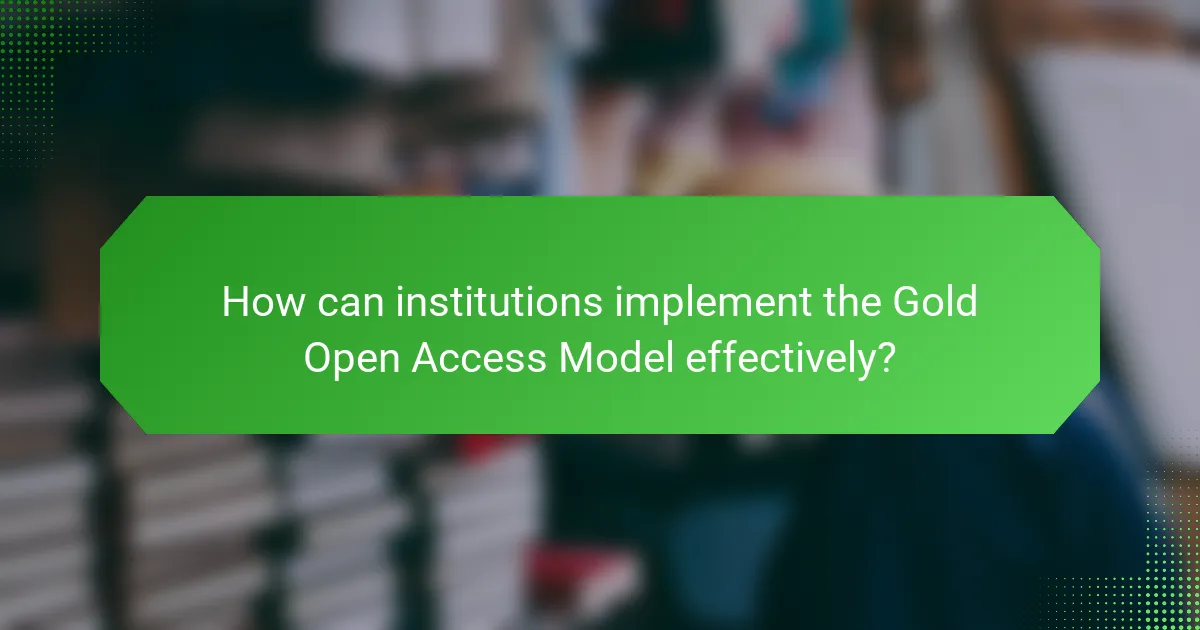
How can institutions implement the Gold Open Access Model effectively?
Institutions can implement the Gold Open Access Model effectively by establishing clear policies and funding mechanisms. They should allocate budgets specifically for article processing charges (APCs). This ensures that authors can publish in open access journals without financial barriers. Institutions can also negotiate transformative agreements with publishers. These agreements allow for both subscription access and open access publishing under one contract.
Training and support for researchers are essential. Institutions should provide resources to help authors understand the open access landscape. They can offer workshops and one-on-one consultations. Additionally, institutions should promote open access publishing as part of their academic culture. This can be achieved through incentives for researchers who publish openly.
Monitoring and assessment of open access initiatives is crucial. Institutions should track publication outputs and their impact on research visibility. By analyzing data, they can adjust strategies to enhance effectiveness. These steps create a supportive environment for Gold Open Access implementation.
What steps should institutions take to adopt the Gold Open Access Model?
Institutions should take several steps to adopt the Gold Open Access Model. First, they need to assess their current publishing practices. This includes evaluating existing subscriptions and publication fees. Second, institutions should establish a clear policy supporting Gold Open Access. This policy should outline funding mechanisms for article processing charges. Third, they must engage with researchers to promote awareness of Gold Open Access benefits. Providing training and resources can facilitate this engagement. Fourth, institutions should collaborate with publishers to negotiate favorable terms for open access publishing. This collaboration can lead to reduced fees and better access. Lastly, institutions should monitor and evaluate the impact of their Gold Open Access initiatives. Regular assessments can help refine strategies and improve outcomes.
How can institutions develop policies to support Gold Open Access publishing?
Institutions can develop policies to support Gold Open Access publishing by establishing clear guidelines for funding and compliance. They should allocate dedicated budgets for article processing charges (APCs) to ensure authors can publish without financial barriers. Institutions can also create partnerships with publishers to negotiate discounted APC rates. Implementing institutional repositories can facilitate the dissemination of open access content. Additionally, institutions should provide training and resources to educate researchers about the benefits and processes of Gold Open Access. Evidence shows that institutions with supportive policies see increased publication rates in open access journals, enhancing visibility and impact of research.
What resources are available for institutions transitioning to the Gold Open Access Model?
Institutions transitioning to the Gold Open Access Model can access various resources. These include guidelines from organizations like the Directory of Open Access Journals (DOAJ). The DOAJ offers a comprehensive list of reputable open access journals. Additionally, the Open Access Scholarly Publishers Association (OASPA) provides best practice guidelines and support. Many universities also have internal resources and support teams to assist with the transition. The Scholarly Publishing and Academic Resources Coalition (SPARC) offers toolkits and advocacy resources. Funding agencies may also provide grants to support the transition to open access publishing. These resources help institutions navigate the complexities of the Gold Open Access Model effectively.
What best practices should authors follow when using the Gold Open Access Model?
Authors should ensure their research is published in reputable Gold Open Access journals. Selecting journals with strong impact factors and rigorous peer review processes enhances credibility. Authors must also comply with the journal’s specific licensing agreements. This ensures proper usage and distribution of their work. Additionally, authors should promote their published work through social media and academic networks. This increases visibility and accessibility to a wider audience. Finally, it is important for authors to keep track of funding requirements related to open access. Many funding agencies require specific open access policies to be followed. These practices help maximize the benefits of the Gold Open Access Model.
How can authors choose the right journal for Gold Open Access publishing?
Authors can choose the right journal for Gold Open Access publishing by evaluating several key factors. First, they should assess the journal’s scope to ensure alignment with their research topic. Next, authors must check the journal’s open access policies, including publication fees and licensing options. They should also consider the journal’s impact factor and reputation within their field. Additionally, reviewing the editorial board’s expertise can provide insights into the journal’s credibility. Authors can utilize databases like Directory of Open Access Journals (DOAJ) to find reputable Gold Open Access journals. Finally, examining previous articles published in the journal can help gauge the quality and relevance of content. These steps will guide authors in selecting an appropriate journal for their work.
What tips can authors use to maximize visibility and impact of their work in Gold Open Access?
Authors can maximize visibility and impact of their work in Gold Open Access by selecting reputable journals with high visibility. Targeting journals indexed in major databases enhances discoverability. Authors should utilize social media platforms to share their research, increasing audience reach. Engaging in academic networks and communities fosters collaboration and visibility. Authors must ensure their work is well-cited in relevant literature, enhancing credibility. Utilizing altmetrics can provide insights into the impact of their work. Applying effective keywords and metadata improves searchability in databases. These strategies collectively enhance the overall visibility and impact of research in Gold Open Access.
What future trends are expected for the Gold Open Access Model?
Future trends for the Gold Open Access Model include increased institutional funding and support. Many universities are allocating more resources for open access publishing. This trend is driven by a growing demand for accessible research. Additionally, there is a rise in transformative agreements between publishers and institutions. These agreements aim to transition subscription-based models to open access. Furthermore, the adoption of open research practices is expected to grow. Researchers increasingly value transparency and collaboration in their work. Lastly, the integration of technology in publishing processes will enhance accessibility and efficiency. These trends indicate a shift towards a more open and equitable research landscape.
How might technological advancements influence the Gold Open Access Model?
Technological advancements may enhance the Gold Open Access Model by improving accessibility and distribution. Digital platforms enable wider dissemination of research outputs. Advanced data analytics can help optimize content visibility and discoverability. Enhanced collaboration tools facilitate partnerships between researchers and publishers. Automation in publishing processes can reduce costs and increase efficiency. Blockchain technology may ensure transparency in funding and publication processes. Overall, these advancements can lead to a more sustainable and effective Gold Open Access Model.
What role will policy changes play in the evolution of the Gold Open Access Model?
Policy changes will significantly influence the evolution of the Gold Open Access Model. Such changes can enhance funding mechanisms for open access publishing. Increased governmental and institutional support may lead to broader adoption. Policy frameworks can establish mandates for open access publication in publicly funded research. This shift can drive researchers to publish in Gold Open Access journals. Furthermore, aligning funding agency policies with open access goals promotes transparency and accessibility. Evidence from the European Commission’s Plan S shows that policy-driven initiatives can accelerate the transition to open access. This demonstrates the potential impact of strategic policy changes on the Gold Open Access Model’s development.
The Gold Open Access Model is a publishing approach that provides immediate and unrestricted access to research articles, typically funded by article processing charges (APCs) paid by authors or their institutions. This model enhances the visibility and citation rates of published work, facilitating wider dissemination of knowledge. The article explores the key characteristics, benefits, and challenges of the Gold Open Access Model, including financial implications and misconceptions. Additionally, it offers strategies for effective implementation by institutions and discusses future trends and the impact of policy changes on the model’s evolution.
